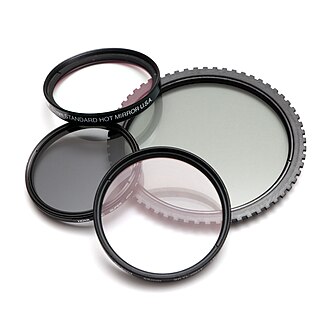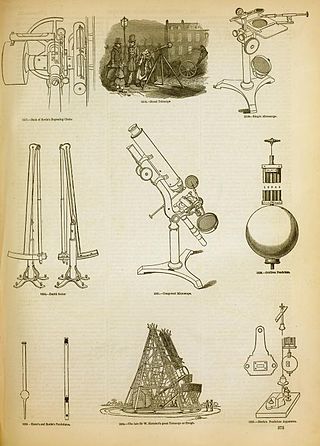Light pollution is the presence of unwanted, inappropriate, or excessive artificial lighting in the visible spectrum. It may also refer to:
Emission may refer to:

Light pollution is the presence of unwanted, inappropriate, or excessive artificial lighting. In a descriptive sense, the term light pollution refers to the effects of any poorly implemented lighting, during the day or night. Light pollution can be understood not only as a phenomenon resulting from a specific source or kind of pollution, but also as a contributor to the wider, collective impact of various sources of pollution.

A space telescope or space observatory is a telescope in outer space used to observe astronomical objects. Suggested by Lyman Spitzer in 1946, the first operational telescopes were the American Orbiting Astronomical Observatory, OAO-2 launched in 1968, and the Soviet Orion 1 ultraviolet telescope aboard space station Salyut 1 in 1971. Space telescopes avoid the filtering and distortion (scintillation) of electromagnetic radiation which they observe, and avoid light pollution which ground-based observatories encounter. They are divided into two types: Satellites which map the entire sky, and satellites which focus on selected astronomical objects or parts of the sky and beyond. Space telescopes are distinct from Earth imaging satellites, which point toward Earth for satellite imaging, applied for weather analysis, espionage, and other types of information gathering.

In telecommunications and computer networking, multiplexing is a method by which multiple analog or digital signals are combined into one signal over a shared medium. The aim is to share a scarce resource – a physical transmission medium. For example, in telecommunications, several telephone calls may be carried using one wire. Multiplexing originated in telegraphy in the 1870s, and is now widely applied in communications. In telephony, George Owen Squier is credited with the development of telephone carrier multiplexing in 1910.

Polarization is a property of transverse waves which specifies the geometrical orientation of the oscillations. In a transverse wave, the direction of the oscillation is perpendicular to the direction of motion of the wave. A simple example of a polarized transverse wave is vibrations traveling along a taut string (see image); for example, in a musical instrument like a guitar string. Depending on how the string is plucked, the vibrations can be in a vertical direction, horizontal direction, or at any angle perpendicular to the string. In contrast, in longitudinal waves, such as sound waves in a liquid or gas, the displacement of the particles in the oscillation is always in the direction of propagation, so these waves do not exhibit polarization. Transverse waves that exhibit polarization include electromagnetic waves such as light and radio waves, gravitational waves, and transverse sound waves in solids.

Nocturnality is a behavior in some non-human animals characterized by being active during the night and sleeping during the day. The common adjective is "nocturnal", versus diurnal meaning the opposite.
Circular dichroism (CD) is dichroism involving circularly polarized light, i.e., the differential absorption of left- and right-handed light. Left-hand circular (LHC) and right-hand circular (RHC) polarized light represent two possible spin angular momentum states for a photon, and so circular dichroism is also referred to as dichroism for spin angular momentum. This phenomenon was discovered by Jean-Baptiste Biot, Augustin Fresnel, and Aimé Cotton in the first half of the 19th century. Circular dichroism and circular birefringence are manifestations of optical activity. It is exhibited in the absorption bands of optically active chiral molecules. CD spectroscopy has a wide range of applications in many different fields. Most notably, UV CD is used to investigate the secondary structure of proteins. UV/Vis CD is used to investigate charge-transfer transitions. Near-infrared CD is used to investigate geometric and electronic structure by probing metal d→d transitions. Vibrational circular dichroism, which uses light from the infrared energy region, is used for structural studies of small organic molecules, and most recently proteins and DNA.

Radio waves are a type of electromagnetic radiation with the longest wavelengths in the electromagnetic spectrum, typically with frequencies of 300 gigahertz (GHz) and below. At 300 GHz, the corresponding wavelength is 1mm, which is shorter than the diameter of a grain of rice. At 30 Hz the corresponding wavelength is ~10,000 kilometers, which is longer than the radius of the Earth. Wavelength of a radio wave is inversely proportional to its frequency, because its velocity is constant. Like all electromagnetic waves, radio waves in a vacuum travel at the speed of light, and in the Earth's atmosphere at a slightly slower speed. Radio waves are generated by charged particles undergoing acceleration, such as time-varying electric currents. Naturally occurring radio waves are emitted by lightning and astronomical objects, and are part of the blackbody radiation emitted by all warm objects.

Observational astronomy is a division of astronomy that is concerned with recording data about the observable universe, in contrast with theoretical astronomy, which is mainly concerned with calculating the measurable implications of physical models. It is the practice and study of observing celestial objects with the use of telescopes and other astronomical instruments.

In photography and cinematography, a filter is a camera accessory consisting of an optical filter that can be inserted into the optical path. The filter can be of a square or oblong shape and mounted in a holder accessory, or, more commonly, a glass or plastic disk in a metal or plastic ring frame, which can be screwed into the front of or clipped onto the camera lens.

Skyglow is the diffuse luminance of the night sky, apart from discrete light sources such as the Moon and visible individual stars. It is a commonly noticed aspect of light pollution. While usually referring to luminance arising from artificial lighting, skyglow may also involve any scattered light seen at night, including natural ones like starlight, zodiacal light, and airglow.

A backlight is a form of illumination used in liquid-crystal displays (LCDs). As LCDs do not produce light by themselves—unlike, for example, cathode ray tube (CRT), plasma (PDP) or OLED displays—they need illumination to produce a visible image. Backlights illuminate the LCD from the side or back of the display panel, unlike frontlights, which are placed in front of the LCD. Backlights are used in small displays to increase readability in low light conditions such as in wristwatches, and are used in smart phones, computer displays and LCD televisions to produce light in a manner similar to a CRT display. A review of some early backlighting schemes for LCDs is given in a report Engineering and Technology History by Peter J. Wild.

An optical instrument is a device that processes light waves, either to enhance an image for viewing or to analyze and determine their characteristic properties. Common examples include periscopes, microscopes, telescopes, and cameras.

RealD 3D is a digital stereoscopic projection technology made and sold by RealD. It is currently the most widely used technology for watching 3D films in theaters. Worldwide, RealD 3D is installed in more than 26,500 auditoriums by approximately 1,200 exhibitors in 72 countries as of June 2015.
Ecological traps are scenarios in which rapid environmental change leads organisms to prefer to settle in poor-quality habitats. The concept stems from the idea that organisms that are actively selecting habitat must rely on environmental cues to help them identify high-quality habitat. If either the habitat quality or the cue changes so that one does not reliably indicate the other, organisms may be lured into poor-quality habitat.

Monochrome photography is photography where each position on an image can record and show a different amount of light, but not a different hue. It includes all forms of black-and-white photography, which produce images containing shades of neutral grey ranging from black to white. Other hues besides grey, such as sepia, cyan, blue, or brown can also be used in monochrome photography. In the contemporary world, monochrome photography is mostly used for artistic purposes and certain technical imaging applications, rather than for visually accurate reproduction of scenes.

Polarization is a property of light waves that describes the orientation of their oscillations. Polarized light pollution is a subset of the various forms of light pollution referring specifically to polarized light.

An astronomical filter is a telescope accessory consisting of an optical filter used by amateur astronomers to simply improve the details and contrast of celestial objects, either for viewing or for photography. Research astronomers, on the other hand, use various band-pass filters for photometry on telescopes, in order to obtain measurements which reveal objects' astrophysical properties, such as stellar classification and placement of a celestial body on its Wien curve.

Ecological light pollution is the effect of artificial light on individual organisms and on the structure of ecosystems as a whole.
The spectral G-Index is a variable that was developed to quantify the amount of short wavelength light in a visible light source relative to its visible emission. The smaller the G-index, the more blue, violet, or ultraviolet light a lamp emits relative to its total output. It is used in order to select outdoor lamps that minimize skyglow and ecological light pollution. The G-index was originally proposed by David Galadí Enríquez, an astrophysicist at Calar Alto Observatory.